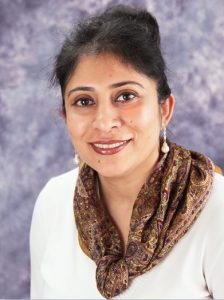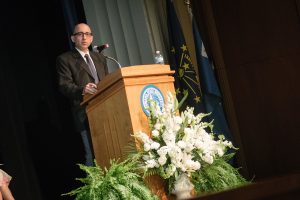Saba Kamal, OTR, CHT
She is the Director of her 2 private practice Hands-On-Care in San Jose, CA. She was the Conference Chair of Hand Therapy Association of California 2011 -2019
Graduated in 1994 from Govt. Medical College, Nagpur, India. Received fellowship training from the Hand Therapy Fellowship program in Houston TX. Ms. Kamal received Certification in Hand Therapy in 2001.

She worked with renowned physicians like Dr. David Lichtman and Dr. Jeffery Budoff. She has been the presenter at Stanford review course, ASHT Ca chapter meetings, and ASHT National conferences 2007, 2008 and at the IFSHT conference in 2010. She was invited to speak at Western Occupational Medicine conference & 2010 Baseball Medicine conference. She has held several full day splinting and taping workshops.
She served as a co-chair in the ASHT’s public relations committee. She was the President of ASHT California Chapter 2010 and 2011. She won the ASHT Chapter Awards 2 years in a row for 2010 and 2011 when she served as the ASHT-Ca Chapter president. She has served as the Conference Chair for Hand Therapy Association of California for the years of 2011, 2012, 2013, 2014, 2015, 2016, 2017, 2018 and 2019. She is now a member of ASSET American Association of Shoulder and Elbow therapists, who place a high value on efficacious exemplary patient care. Her poster Wide buddy loop for treatment of index RCL was nominated for best poster award for 2012 ASHT conference. She was the invited speaker at AAHS conference on Neuropathic pain in Arizona.
She was a speaker at ASSET in Oct 2018, AAHS in February 2019 and hosted a panel discussion on Neural Gliding with Dr. Curtin, Dr. Haggert, and Ashim Bakshi in Berlin, Germany in 2019 at the IFSHT meeting.
You can view her entire resume by clicking below
Ashim Bakshi, OTR, MHS, CHT
Ashim Bakshi is the owner and clinical director of Hand and Orthopedic Rehab Clinic, which is a specialized outpatient clinic with 2 locations in Terre Haute and Brazil, Indiana.
Graduated in 1995 from Delhi University with a Bachelor’s in Occupational Therapy. He received his graduate fellowship in hand therapy from Texas Wo men’s University and Baylor College of Medicine in Houston TX in 2002. He completed Masters in Health Sciences in Occupational Therapy with specialization in orthopedics fr
men’s University and Baylor College of Medicine in Houston TX in 2002. He completed Masters in Health Sciences in Occupational Therapy with specialization in orthopedics fr
om University of Indianapolis in 2005. Ashim has presented locally and nationally on topics relating to upper extremity orthopedic rehab including at the 2007 and 2008 ASHT national conferences and as a keynote speaker at the Texas Chapter of ASHT. He served as a co-chair in the ASHT’s professional relations committee.
Ashim has also served as a guest lecturer at Indiana State University’s Graduate Athletic Training Program. He has been the invited keynote speaker at Indiana Worker’s Compensation Institute . He is an active member of the American Society of Shoulder and Elbow Therapists. Ashim is also the consultant, clinical instructor and adjunct faculty at Indiana State University’s Occupational Therapy graduate program.

Commencement speech
Ruminations from 20 years and the future……
February 2016 marked 2 decades we have been in the United States. Ashim Bakshi and I did our undergrad in occupational therapy in India and then gathered our experiences as travelling therapists here in the US. We completed our graduate fellowship program at Baylor College of Medicine and Texas Woman’s University in Houston and got the opportunity to be trained under world class orthopedic, hand and plastic surgeons and therapists, and then went off to treating patients and gathering experiences our separate ways in different parts of the country.
Few years later we joined hands to start Advanced Rehab Seminars. We realized that most hand therapy education is theoretical book knowledge, with therapists struggling with the clinical applications. This we saw across the spectrum, new and experienced therapists, who have been in the field stuck in a rut. This led us to start the hands-on courses with Advanced Rehab Seminars for the Upper Quadrant with enhanced focus on functional and applied anatomy from shoulder to the hand.
Our first course was in 2010 on Manual Medicine for the Upper Quadrant-Taking it to the next level. Here we reviewed basics of anatomy, palpatory examination and transitioned to drawing the joint articulation as part of the surface anatomy so that the clinicians could accurately palpate and perform the mobilization with correct hand position. The course was an instant success.
Then we found similar problems in treating sports injuries. Understanding how sports injures happen and how you have to think outside the box to treat one and get the patient back into the game or when to hold them back. We included sports splinting and taping with it to make it a package in Sports Medicine for the Upper Quadrant
After this we did Differential Diagnosis and assessment of the upper quadrant. The entire process of Advanced Rehab started with us giving a talk at ASHT on Differential Diagnosis, and the feedback we got we knew we had to do something. Therapists wanted more, so we finally put together our most famous course Paradigm of differential diagnosis, assessment, treatment of the upper quadrant nerve & orthopedic systems. The premise of this course was that we do not have X-rays or MRI’s to detect problems and all we have is our assessment skill and physical tests, and as therapists we need to be thorough at doing these tests. As is, the MRI’s have to correlate with the physical finding and if it doesn’t the expensive test is useless.
The next project we undertook was Comprehensive management of the post-surgical arm. With the latest advances in surgeries, therapists needed to understand these surgeries so that they would not harm the patients when treating them. We picked a few of the latest surgeries and designed problem solving techniques based on when the patient was referred to therapy to avoid a cook book approach so that the patient can be treated appropriately.
Stiff arm imposes multiple challenges not just to the patient but to the treating therapist and is a true test of skills for the therapist to prove to the referring provider. It requires a multifaceted approach from ongoing assessment to treatment which is ever changing from splinting to mobilization to modalities not to mention getting the patients confidence to allow the treatment to occur and participate in it. It tests the therapist’s skill in every aspect and pays huge rewards when done right.
Now a days taping is done by all, for every injury there is taping, primarily Kinesio taping. We wanted to bring a different approach to taping. One has to know all there is in taping and not get stuck to one type. We do not know what a patient will walk in with and we should provide answers for these patients and for that we should have the knowledge to use all there is in our tool box. Thus we introduced. Comparative taping Leuko Vs. Kinesio taping. Leuko taping is done primarily in lower extremities but we designed techniques and extrapolated the concepts, to be used in the upper quadrant from shoulder to hand and compared the taping methodologies, to obtain an optimum outcome.
Our upcoming project is Neural Mobilization of the Upper Quadrant with Myofascial Mobilization. The premise of this course is based on the fact that nerves are sitting in a bed of tissues. Just giving nerve glides doesn’t ensure that the nerve is gliding in the scarred or newly altered bed. Assessing where the nerve is tied down, mobilizing the structures at its base and then slowly gliding the nerve and continuing to provide the environment via taping will ensure the normalization of sensation and pain modulation.
In addition to the courses we developed, we invited our mentor Charles Costello to do a modalities course so that the therapist knows the reasoning behind every modality they use and apply it correctly.
Along with this we are also working on a new course on treating Major Injuries “A Practical Approach In solving Complex Upper extremity Cases “. The course includes application of applied physics and psychology in the mix to treat these complex injuries and it would include practical application to actual case studies and how they were resolved.